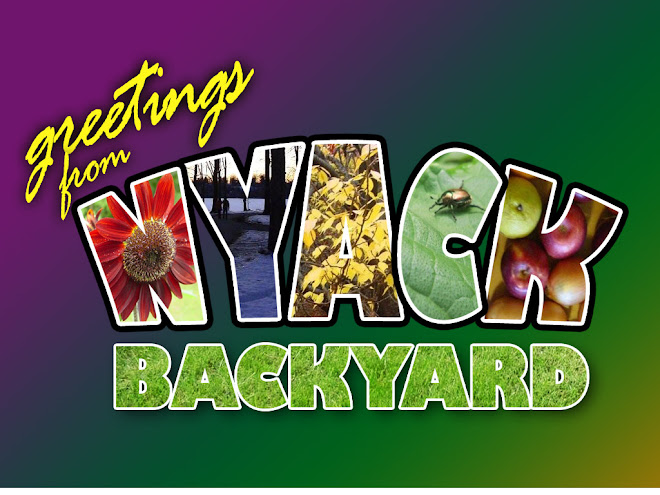 Do you have one plant that almost didn't make it? That had a tough start, a near-death experience or serious injury? A plant that you started from seed and thought might never bloom? This year it was my milkweed.
Do you have one plant that almost didn't make it? That had a tough start, a near-death experience or serious injury? A plant that you started from seed and thought might never bloom? This year it was my milkweed.  It took a long time to germinate. Then half of the seeds died in my closet under a flourescent light, so I tried again in the school greenhouse. They were tiny, tiny, tiny for so long. You can barely see them in this photo in the lower left foreground.
It took a long time to germinate. Then half of the seeds died in my closet under a flourescent light, so I tried again in the school greenhouse. They were tiny, tiny, tiny for so long. You can barely see them in this photo in the lower left foreground.  I'm glad I persevered.
I'm glad I persevered.This variety is Tropical Milkweed (Asclepias curassavica) and it's an annual.
 I'm hoping I'll be able to save some seeds and try it again next year, but am looking for some native varieties too. There are over 100 varieties of milkweed that grow in the US. Common milkweed is Asclepias syriaca.
I'm hoping I'll be able to save some seeds and try it again next year, but am looking for some native varieties too. There are over 100 varieties of milkweed that grow in the US. Common milkweed is Asclepias syriaca.Why grow milkweed? Milkweed is the only plant where a Monarch butterfly will lay her eggs. When they hatch, the caterpillar's favorite food (milkweed leaves) is there in abundance --
 (the above photo is courtesy of New York City Parks.)
(the above photo is courtesy of New York City Parks.)Turns out milkweed is the only plant that wee Monarch caterpillars can eat.
 Milkweed also produces a nectar that butterflies love and a when the pods open, an abundance of seeds, each with it's own silky little parachute that carries it away.
Milkweed also produces a nectar that butterflies love and a when the pods open, an abundance of seeds, each with it's own silky little parachute that carries it away.Long ago naturalists discovered that birds would sicken, vomit and even die after eating certain butterflies. The reason the birds got sick is because they were eating Monarchs that were loaded with a cardenolides (cardiac-active steroids) that were still concentrated in their bodies from eating milkweed when they were caterpillars. So the milkweed's even keeping them from getting eaten themselves!
Milkweed is used medicinally to treat bowel and kidney disorders and hemp from it's stems can be twisted into spring or rope.
 Sadly, Monarchs are having a tough time finding milkweed. As land is developed in Mexico where they overwinter, and strange weather patterns increase, native milkweed habitats are disappearing.
Sadly, Monarchs are having a tough time finding milkweed. As land is developed in Mexico where they overwinter, and strange weather patterns increase, native milkweed habitats are disappearing.  So plant some milkweed, whydontcha? Read more about the milkweed growing campaign and get seeds here.
So plant some milkweed, whydontcha? Read more about the milkweed growing campaign and get seeds here. 
7 comments:
Beautiful photos, Jen! Very inspiring story. I'm going to commit to growing this one next year, I'm going to everything I can to encourage butterflied in my garden.
Your milkweed shot is great~~a beautiful flower in a bouquet on the table...but that defeats the purpose of growing it! There's a grower who sells it at the farmer's market..so it's not being cut from my garden. ...thanks for letting us know it will provide food, too! gail
Your milkweed is beautiful. I don't have it growing in my yard. I do have other host plants for other types of butterflies. Cassia or Candlestick for the White Cloudless Sulphur. Passionvine for the Gulf Fritillary. And in the spring, dill for the Black Swallowtail. I really should add Milkweed!
Blessings,
Lorilee
Lovely! Your story is another example of how patience is so necessary if you want to be a contented gardener. There are lots of milkweeds in the park next door to me but I've never seen them bloom with these nice flowers. Which comes first: the pods filled with silky seeds or the flowers?
Hi Jen...Great post on the Milkweed plant and Monarchs, lots of info! Fortunately, I have Milkweed growing naturally in the woods. I'm going to have to check into that tropical milkweed...so pretty. I finally had success this year growing Cosmos from seed...never before! My gardening days are basically over, though, I've let 4 large beds grow in. Always have my dragonflies, though!
P.S...Thank you for spreading the word on my pet project, they say word of mouth is the best advertisement...any help appreciated! Hope you enjoy fall!
That's it! I'm planting some milkweed next spring - your plants look gorgeous & I love the blossoms!
What a wonderful and informative blog post - thank you for that!
Viviane... :)
Hi Jen, what a fabulous job you did raising the milkweed from seed and getting blooms! It usually takes a couple of years before our seed grown A. tuberosa gets flowers. We have the milkweeds and are ready, hope the monarchs come for a visit on their long journey. :-)
Frances
Post a Comment